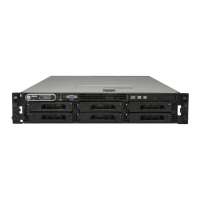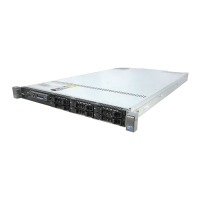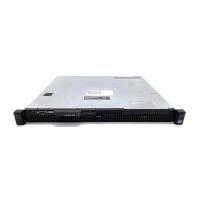STORAGE
DELL POWER SOLUTIONS | May 200890
Reprinted from
Dell Power Solutions,
May 2008. Copyright © 2008 Dell Inc. All rights reserved.
calculations; and support for an Intelligent
I/O (I2O) message unit helps maximize
performance. The controller is powered
by a state-of-the-art LSI 1078 ROC con-
troller, which includes both instruction
and data cache to help provide an addi-
tional performance boost. This solid hard-
ware foundation is designed to simplify
integration of new RAID firmware features
and performance increases in future
release updates.
Caching policies
Flexible caching policies in PERC 6 control-
lers allow administrators to tune cache writ-
ing schemes to help optimize performance
or maximize data protection, including
choosing between write-through caching
and write-back caching. With write-through
caching enabled, the controller transfers a
block of data directly to the disk, and does
not send an acknowledgment of data trans-
fer completion to the host system until the
data is committed to the disk subsystem.
With write-back caching enabled, the con-
troller sends a data transfer completion
signal to the host when the controller cache
has received all data in a transaction, and
the controller then writes the cached data
to the storage device when system activity
is low or when the write buffer approaches
capacity; the cached data is not written to
the storage device immediately.
Write-through caching typically pro-
vides a data security advantage over
write-back caching, while write-back
caching typically provides a performance
advantage. The risk of using write-back
caching is that the cached data can be
lost if a power failure occurs before the
data is written to the storage device. This
risk can be mitigated by using the battery
backup units on PERC 6 controllers.
Read and I/O policies
Read policies determine the type of read
option for a logical drive and can be set
to normal (the default setting), read-
ahead, or adaptive. The normal setting
specifies that the controller reads only the
requested data and does not read ahead
for the current logical drive. The read-
ahead setting specifies that the controller
reads sequentially ahead of requested data
and stores the additional data in cache
memory, anticipating that the data will be
needed soon; this policy typically supplies
sequential data faster than the normal (no-
read-ahead) setting, but is not as effective
when accessing random data. The adaptive
setting specifies that the controller begins
using read-ahead if the two most recent
disk accesses occurred in sequential sec-
tors. If all read requests are random, the
algorithm reverts to the normal setting;
however, requests are still evaluated for
possible sequential operation.
I/O policies are used to enable read
buffering in cache memory and apply to
reads on a specific logical drive. This set-
ting does not affect the read-ahead cache.
The cached I/O setting specifies that the
controller buffers reads in cache memory,
while the direct I/O setting specifies that
reads and writes are not buffered in cache
memory. This setting does not override
the read policy settings; data is trans-
ferred to cache and the host concurrently.
If the same data block is read again, it
comes from cache memory.
Software features
Enabling disk caching can have a signifi-
cant impact on system performance, but
the potential for data loss increases if
power to the disk drives is lost while data
written to the disk is still in the cache.
Native command queuing (NCQ) for SATA
and tagged command queuing (TCQ) for
SAS hard drives helps increase perfor-
mance by allowing individual hard disks
to optimize the order in which read and
write commands are executed.
SIMPLIFIED MANAGEMENT
PERC 6 controllers integrate technologies
and applications designed to simplify
management for IT administrators. For
example, SAS disk connectivity capabili-
ties have made it increasingly common to
connect a large number of disks to a PERC
controller, and PERC 6 controllers include
features that can automatically track disk
order and organization through disk roam-
ing. PERC 6 controllers also support
moving physical disks from one cable con-
nection or backplane slot to another on
the same controller; the controllers can
automatically recognize the relocated
physical disks and logically place them in
the appropriate virtual disks that are part
of the disk group.
Other advanced online capabilities
allow administrators to migrate disks from
one controller to another. The Advanced
Import feature enables administrators to
import, or migrate, disk arrays created
by a different PERC controller while the
server remains online. The controllers can
even import partial, or degraded, arrays
and provide array preview capabilities
before import to further enhance data
serviceability.
Dell PERC 6 controllers utilize Smart
Cache Technology that offers administra-
tors pre-tuned cache ratios for read and
write operations that automate cache
“
As enterprise data requirements con-
tinue to increase, deploying powerful,
easy-to-manage RAID solutions can
become essential for organizations
seeking to simplify their IT environ-
ments while increasing controller and
storage reliability and server uptime.”

